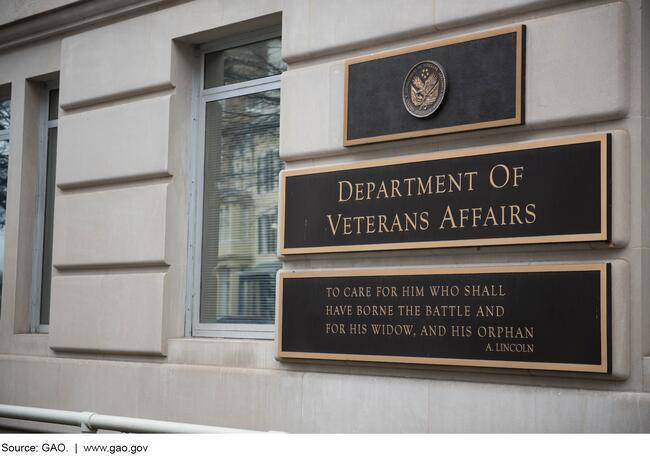VA Health Care: VA Needs to Continue to Strengthen Its Oversight of Quality of State Veterans Homes
Fast Facts
Ensuring quality care at nursing homes has become even more critical with the emergence of COVID-19.
The Department of Veterans Affairs provided nursing home care for over 39,000 veterans in 2019. More than half received care at homes that states own and operate. The VA pays a contractor to inspect these homes.
We testified about our June 2019 findings on state home inspections. We made 3 recommendations, 1 of which—developing a strategy for regularly observing inspections—has been addressed. The others concern additional requirements for contractors issuing citations and providing state home quality information on the VA website.

Highlights
What GAO Found
The Department of Veterans Affairs (VA) pays over $1 billion a year to state veterans homes (SVH)—homes owned and operated by the states—to provide nursing home care to approximately 20,000 veterans. In fiscal year 2019, VA paid SVHs $1.17 billion for an average daily census of 20,072 veterans (51 percent of the total veterans receiving nursing home care through VA). Further, VA projects its payments to SVHs will continue to increase; VA projects it will pay $1.7 billion to SVHs to provide care to veterans in fiscal year 2022.
VA oversees the quality of care veterans receive at SVHs mainly through annual inspections that VA hires a contractor to perform. In its July 2019 report, GAO found that VA's SVH contractor performed the required annual inspections for all SVHs in 2018, but VA needed to take action to enhance its oversight of SVHs and to ensure that information on quality of care provided in this setting is publicly available to veterans. Specifically, GAO found the following:
- VA does not require its SVH contractor to identify all failures to meet quality standards during its inspections as deficiencies . For example, GAO found that VA allows its SVH contractor to cite some failures to meet quality standards as “recommendations,” rather than as deficiencies. VA officials said they do not track or monitor the nature of the recommendations or whether they have been addressed. As a result, VA does not have complete information on all failures to meet quality standards at SVHs and cannot track this information to identify trends in quality across these homes.
- VA is not conducting all monitoring of its SVH contractor. GAO found that, at the time of its review, VA had not monitored the SVH contractor's performance of inspections through regular observational assessments to ensure that contractor staff effectively determine whether SVHs are meeting required standards. Specifically, VA officials said they intended to observe the SVH contractor's inspections on a quarterly basis; however, at the time of GAO's review, VA officials could not recall when VA last observed the SVH contractor's inspections. In July 2020, VA provided information indicating that they will regularly monitor the SVH contractor's performance in conducting inspections through observational assessments.
- VA does not share information on the quality of SVHs on its website. GAO found that, while VA provides information on the quality of other nursing home care settings on its website, it does not do so for SVHs. According to VA officials, there is no requirement to provide information on SVH quality on its website, as SVHs are owned and operated by the states. VA is the only federal agency that conducts regular oversight inspection on the quality of care of all SVHs and, as a result, is the only agency that could share such quality information on its website.
Why GAO Did This Study
Veterans—like over a million other Americans—rely on nursing home care to help meet their health needs. For eligible veterans whose health needs require skilled nursing and personal care, VA provides or pays for nursing home care in three nursing home settings: the VA-owned and -operated community living centers, public- or privately owned community nursing homes, and state-owned and -operated SVHs. In fiscal year 2019, VA provided or paid for nursing home care for over 39,000 veterans. The majority of these veterans received care at SVHs.
This statement summarizes the GAO's July 2019 report, GAO-19-428 , with a focus on issues related to SVHs. Specifically, it describes the: (1) use of and expenditures for SVHs, (2) inspections used by VA to assess the quality of SVH care and VA's oversight of the inspection process, and (3) information VA provides publicly on the quality of SVH care. As part of that work GAO analyzed VA data on expenditures for SVHs and interviewed VA officials. For this statement GAO reviewed expenditure and utilization data for fiscal year 2019.
Recommendations
In its July 2019 report, GAO made three recommendations related to SVHs, including that VA require that all failures to meet quality standards are cited as deficiencies on SVH inspections. VA concurred with two recommendations and concurred in principle with the third. VA has addressed one recommendation and continued attention is needed to address the two remaining recommendations.
